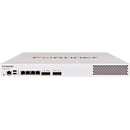Description
Fortinet FortiWeb FWB-400E is a purpose-built, high-performance web application firewall designed to safeguard enterprise web applications and APIs from known and emerging exploits. Engineered for large-scale deployments, this hardware appliance delivers machine learning-driven application profiling, rigorous threat protection, and a seamless user experience even under heavy traffic. With FortiGuard threat intelligence and tight integration into Fortinet’s Security Fabric, FortiWeb FWB-400E provides comprehensive protection, centralized management, and scalable defense across data centers, branches, and edge locations.
- Comprehensive protection for web apps and APIs: The FortiWeb FWB-400E models each application, learns normal behavior, and automatically creates precise protection profiles that shield web apps and APIs from SQL injections, cross-site scripting (XSS), command injection, and evolving zero-day exploits.
- ML-powered adaptive security: Application profiling uses machine learning to recognize legitimate patterns for every application, enabling adaptive, self-tuning security that reduces false positives while catching sophisticated attacks.
- Advanced bot and automated threat mitigation: FortiWeb’s bot detection and mitigation capabilities distinguish automated threats from legitimate traffic, blocking credential stuffing, scraping, automation, and credential reuse attempts in real time.
- API security at scale: In an API-first world, FortiWeb protects REST and GraphQL endpoints with strict input validation, threat intelligence, and anomaly detection to prevent API-specific abuse and data leakage.
- Compliance-ready and easy to manage: FortiWeb supports industry regulations (PCI-DSS and others) with audit-ready logs, granular policy control, and centralized management through Fortinet’s Security Fabric, simplifying governance across environments.
Technical Details of Fortinet FortiWeb FWB-400E
- Model: Fortinet FortiWeb FWB-400E
- Form factor: Hardware-based Web Application Firewall appliance designed for on-premises deployment in data centers, regional hubs, or edge locations.
- Protection scope: Web application firewall, API security, bot mitigation, and advanced threat protection integrated into a single appliance.
- Threat intelligence: Real-time updates and integration with FortiGuard services to enhance protection against new vulnerabilities and emerging attack patterns.
- Compliance and governance: Built-in support for regulatory requirements and audit-ready logging to assist with PCI-DSS, HIPAA, GDPR, and other frameworks.
- Performance characteristics: Optimized for low latency and high request volumes, with hardware acceleration designed to handle demanding web workloads while preserving user experience.
- Fabric integration: Designed to integrate with Fortinet Security Fabric for cross-silo visibility, automated threat containment, and coordinated responses across endpoints, networks, and cloud services.
how to install Fortinet FortiWeb FWB-400E
- Plan deployment: Identify whether the FortiWeb FWB-400E will sit in a data center, regional hub, or at the network edge, and map its network interfaces to management, data, and upstream/downstream paths.
- Rack and power: Install the appliance in a secured rack, connect to power, and attach network cables to the designated management and data ports as per your topology.
- Access the management interface: Power on, obtain the management IP address, and log in using the initial administrator credentials through a trusted workstation on the management network.
- Update firmware and licenses: Check for the latest FortiWeb firmware and apply any required licenses or subscriptions, including FortiGuard threat feeds and Security Fabric licensing if applicable.
- Configure initial system settings: Set time zone, NTP, admin password, and basic network settings to ensure reliable logging and monitoring.
- Create security profiles: Define WAF policies, API protection rules, bot mitigation settings, and attack signatures tailored to your applications and data.
- Enable threat intelligence and Fabric integration: Activate FortiGuard updates and connect FortiWeb to the Fortinet Security Fabric for centralized visibility and automated threat containment.
- Add applications and profiling: Register each web application and API, allowing FortiWeb to learn behavior and generate application-specific protection profiles.
- Validate and monitor: Run live traffic tests, verify policy effectiveness, and set up alerts and dashboards to monitor security events, performance, and logs in real time.
Frequently asked questions
- What is Fortinet FortiWeb FWB-400E? It is an enterprise-grade hardware Web Application Firewall appliance designed to protect web applications and APIs from common and advanced threats, with ML-driven profiling, bot mitigation, and API security capabilities.
- What does FortiWeb FWB-400E protect? It protects web applications, APIs (REST and GraphQL), and automated traffic against attacks such as SQL injection, XSS, command injection, credential stuffing, scraping, and other bot-driven threats, while ensuring a smooth user experience.
- How does machine learning profiling help? ML profiling learns normal application behavior over time, enabling adaptive, self-tuning security that reduces false positives and improves detection of sophisticated and zero-day attacks.
- Is PCI-DSS and other regulatory compliance supported? Yes. FortiWeb offers audit-ready logging and policy controls that help meet PCI-DSS, HIPAA, GDPR, and other regulatory requirements, simplifying governance across environments.
- Can FortiWeb integrate with Fortinet Security Fabric? Yes. FortiWeb is designed to integrate with Fortinet Security Fabric to provide cross-silo visibility, automated threat containment, and coordinated responses across endpoints, networks, and cloud services.
- Where is FortiWeb FWB-400E best deployed? It is optimized for on-premises deployment in data centers, regional hubs, and edge locations, delivering low latency and high throughput for demanding web workloads.
Customer reviews
Showing - Of Reviews


